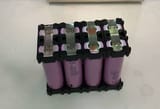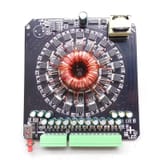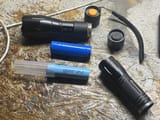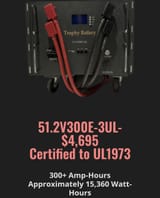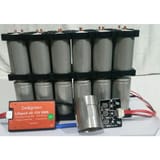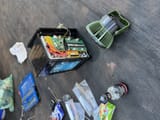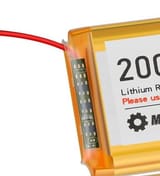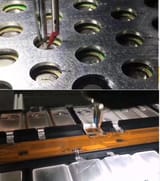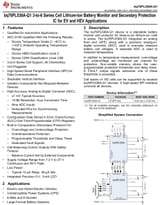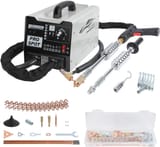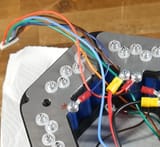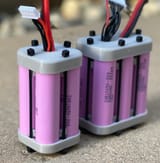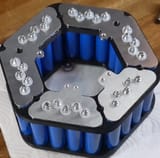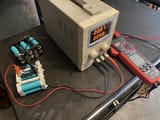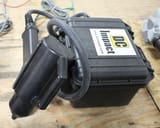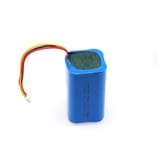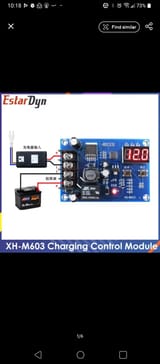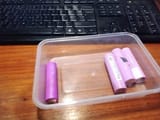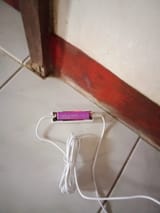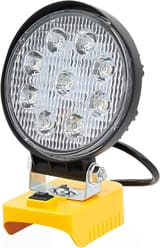Battery general (?)
Would anybody be interested in a thread all about batteries, battery tech/chemistry, cells, building your own packs or scavenging cells from old packs, making your own chargers, etc?
I'll start off in the next post.
In an ideal world, wouldn't it be best to have the charge controller able to measure the voltage of each cell individually, no matter how many cells you have, how many are in series, how many are in parallel, etc? If I'm using an arduino or something to monitor voltage and control charging the main limitation would seem to be the number of pins available. I know there are multiplexing chips you can use to let you control as many power transistors as you want, but is there something similar with analog measurements?
Another stupid idea I had involves using a shit ton of buck/boost converters and basically hook each one up to its own cell or maybe a few cells in in series rather than having each cell/group of cells in parallel with each other. My thinking here is that if you have a bunch of cells in varying states of health, you can still use them all together because when one group's voltage drops out earlier than the others, it just stops supplying power while the others take up the slack. Basically it might let you use mostly dead cells with halfway decent ones, just to squeeze out the last bit of life from a cell before it gets decommissioned.
Anonymous
5/18/2025, 10:26:51 PM
No.2917876
[Report]
>>2917891
>>2918150
>>2917867
There are analog multiplexers like the CD4051 or switches like CD4066 but it become impractical once you have many cells, but since many microcontrollers have built-in multiplexers in their ADC inputs it's easier to just chain a bunch of micocontrollers all connected to an insulated digital bus, like tesla and many others do in their battery cells
See
https://github.com/stuartpittaway/diyBMSv4 for an open-source version where each module controls a single cell
>>2917871
There's plenty of chinese active balancers that can balance up to 8A, but it's best to just test indivudually each cell and spread them evenly in the pack
>>2917867
>wouldn't it be best to have the charge controller able to measure the voltage of each cell individually, no matter how many cells you have, how many are in series, how many are in parallel, etc?
For parallel groups of cells, their voltages will all be the same. By definition, they must be; they're all the same node, and a single electrical node cannot have more than one voltage at a given time. In reality, there is a slight difference due to the non-ideal nature of real conductors, but it's very small.
For series strings of cells (or groups of cells), your practical limitation is mostly voltage. Your number of choices in ADCs and/or multiplexers becomes greatly limited above about 30V, never even mind the high-voltage packs often seen in vehicles. At that point, the obvious move is to simply have individual modules that can track the state of, say, 4-12 cell groups. Those then communicate with a central controller that's galvanically isolated from them, usually via optocouplers, though some us inductive coupling (I think the Leaf's BMS does this).
I actually spent a lot of time designing a BMS (which will never see the light of day, now) that could do 18-cell strings and be linked with itself to create arbitrarily high voltage packs. This was back when the Rona was in full swing and everyone and their mother was backordered for 8 months or more on their BMS chips. I discovered one of the major problems with the "one module per cell" approach was ensuring consistent voltage measurements between cell groups. The only way to do it is to have very precise references, which balloons the cost of the system when you need one for every cell. I ended up creating my own analogue mutiplexer using a flying capacitor, instead. It should have worked, but it adds a shitton to the BoM. After the chip shortage was over, it was just straight-up worse than using one of TIs integrated chips.
Anonymous
5/18/2025, 11:20:31 PM
No.2917889
[Report]
>>2918098
Still Looking for a High Amp Hour LiFePo4 Battery for my Solar Setup.
Any recommendations or Am I Looking at Connecting Panasonic 18650s together and Buying a Spot Welder?
Anonymous
5/18/2025, 11:25:04 PM
No.2917891
[Report]
>>2917892
>>2918375
>>2917871
>you can still use them all together because when one group's voltage drops out earlier than the others, it just stops supplying power while the others take up the slack.
That's already what happens in a parallel cell group. Weaker cells experience slightly more voltage drop internally, which causes them to provide less of the total current being drawn from the cell group. The cells in better condition sag less, and, thus, provide proportionately more current. As long as each group of cells has a similar distribution of healthy/weak cells, you don't need any kind of active control over their power output.
It's still probably not a great idea. Extra heat generated by the shitty cells will accelerate aging in the good ones. If you got them all for extremely cheap, yeah, I guess you might as well, but, aside from that...
>>2917876
>that pic
I cannot really figure out why you'd go through so much effort for active balancing. If the pack was reasonably well-built in the first place and you keep appropriate buffers before 100% and 0% SoC, the amount of balancing you actually need to be doing should easily be handled by just burning off the excess. Yes, it's technically less efficient, but I'd wager that you're looking at less than 0.5% of the pack's total energy being wasted, at worst. The only real benefit is not having to deal with the heat generated by the balancing resistors.
Anonymous
5/18/2025, 11:35:13 PM
No.2917892
[Report]
>>2917891
>I cannot really figure out why you'd go through so much effort for active balancing.
Because there are enough people with money that will buy it
Also compared to the more common variant that uses capacitor charge pumps and can only shift power between adjacent cells it looks pretty cool
Anonymous
5/18/2025, 11:59:37 PM
No.2917900
[Report]
>>2918098
>>2918376
Where my Na-ion bros at?
Anonymous
5/19/2025, 2:12:05 AM
No.2917933
[Report]
>>2917967
>>2917864 (OP)
I would like a battery thread yeah. Could use some chargable aa/aaa recommendations, but I really need a chargeable flashlight with a battery that isn't complete dogshit and preferably not maglite hueg.
Kevin Van Dam
!ZNBx60Gj/k
5/19/2025, 4:23:34 AM
No.2917967
[Report]
>>2917995
>>2933016
>>2917933
There’s a million good options these days. Even the cheap ones aren’t bad. The worst thing about cheap lights is that 99¢ 18650s are always shitty, so get yourself a Kobalt or Hercules battery pack for a few bucks and a cheap 18650 charger and you can stick them in all sorts of flashlights. These 2 for $15 “tac-lights” that fucking everybody has rebranded for the past 10 years are solid if you rip the 3xAAA holder out and stick a good lithium cell in it.
>>2917967
>The worst thing about cheap lights is that 99¢ 18650s are always shitty, so get yourself a Kobalt or Hercules battery pack for a few bucks and a cheap 18650 charger and you can stick them in all sorts of flashlights
You mean parting out the tool batteries for its babies I'm assuming? Interesting to know those are 18650's. What about ryobi's? I have an old hen that might have a few good eggs left in it.
>These 2 for $15 “tac-lights” that fucking everybody has rebranded for the past 10 years are solid if you rip the 3xAAA holder out and stick a good lithium cell in it.
That's a good tip, I didn't realize you could just do that. I was looking for usb cable charge ones but I guess I could just get a multi charger for more AA/AAA's that include a 18650 slot.
Anonymous
5/19/2025, 6:04:02 AM
No.2917997
[Report]
>>2918098
I'm in the market for LiFePO4. I have zero interest in building one. I want plug and play with UL certification.
I'm 90% set on Trophy. they have BMS & built in heaters. our batteries & control system are mounted in a shed we built, with panels mounted on tip. its aboot 18m away from the house, not heated and not well insulated.
we currently have 8X Trojan T-1275 FLA S/P to 48v for 300AH. however, at 50% DOD that's only 150ah usable. the trophy is rated 300AH at 90% DOD, but it tests closer to 310AH. I have taken good care of my Trojans, but they are 4 years old. I am planning ahead.
massive financial gut punch, but it would more than double our storage.
>>2917889
Only absolute retards use 18650 for large batteries. Buy prismatic cells if you're gonna /diy/. Buy cheap chink pre-made batteries if you're not gonna /diy/.
>>2917900
Na-ion was unexpectedly not so good, after all the hype.
>>2917997
>with UL certification
>prebuilt
$4.5k for 15kWh is about as good as it's gonna get there. /diy/ is $800 for ghetto tier, $1500 normal with battery kit, $3k for chinkshit prebuilt.
>>2917888
> For parallel groups of cells, their voltages will all be the same
No (as you say) that depends on using perfect conductors everywhere. With high currents the claim is blatant nonsense.
Moreover, the *currents* won’t be the same.
So, to measure those, each cell is welded to an aluminum wire, fuse/current shunt. Like tesla does for their 18650 based packs. From there, you can measure the voltages and currents in a round-robin pattern through the equivalent of a CD4051 like in
>>2917876
> but that won’t give me accurate absolute values immediately when I plug it in
You don’t need those. It calibrates itself based on an initial “good” pack to make up for the analog mux switch differences and the length and weld differences in the Al wire (etc.)
Anonymous
5/19/2025, 9:31:55 PM
No.2918151
[Report]
>>2918098
> absolute retards use 18650 for large batteries
Pretty much. It’s cheaper to go bigger.
If you go small, it makes sense only if you have an expensive system that lets you detect and swap out individual cells for low individual cell replacements…. And after a few years, with enough cells, statistically you’ll be doing those every day.
Anonymous
5/19/2025, 11:13:32 PM
No.2918175
[Report]
>>2918256
is there some good battery store in the EU? Im looking for some battery with a JST 1.25 connector.
Also what the fuck is everybody smoking where the same connector has thirty names and why are there so many in general?
Oh yes i bet the .25 mm smaller one needs a new standard and multiple names.
Anonymous
5/19/2025, 11:19:45 PM
No.2918178
[Report]
>>2918256
>>2918098
>prismatic cells if you're gonna /diy/. Buy cheap chink pre-made batteries
Reasonably trusted prismatic cells are expensive and the cheap batteries often have high resistance used cells
I've built 3 batteries of 96x 32650 cells each 3 years ago and they're holding up well, they're easy to put togheter using plastic holders and metal strips to make parallel and BMS connections, materials cost half of a comparable ready made battery and all the cells from the supplier I bought were good.
Anonymous
5/20/2025, 2:44:08 AM
No.2918209
[Report]
>>2917995
>what about ryobi's
have fun:
https://docs.google.com/spreadsheets/d/e/2PACX-1vRghl-44o7Nw_GGOGKN8PdnxJtbzF7UR7nYDt3zEPrRL_azznKE1w4QvBJRLxdQnecwIgQ6tuuzQ4bT/pub#
Also just get a convoy and add on a battery. I bought 2 for backups recently and $15 apiece for a fully serviceable light isn't too bad.
Anonymous
5/20/2025, 6:58:03 AM
No.2918256
[Report]
>>2918320
>>2918175
It's because everyone messing with batteries can solder and most can also crimp connections, so you buy any battery that's good and then attach the connector you want.
>>2918178
>Reasonably trusted prismatic cells are expensive and the cheap batteries often have high resistance used cells
$60-80/kWh is not expensive. The only disadvantage is that you have to build a big battery to get good cost/kWh, building a few kWh isn't as cheap as the standard 15kWh.
https://www.nkon.nl/en/rechargeable/lifepo4/prismatisch.html
Anonymous
5/20/2025, 7:07:02 AM
No.2918259
[Report]
>>2918333
Didn’t see this thread, got a battery full of water
>>2918251
>>2918251
Going to dry this out and then seal it back up, can I just silicone it all back up or should the casing be vented for heat/gasses? (The reason it was full of water was it wasn’t water/airtight from factory)
Anonymous
5/20/2025, 12:44:21 PM
No.2918320
[Report]
>>2918256
>It's because everyone messing with batteries can solder and most can also crimp connections, so you buy any battery that's good and then attach the connector you want.
I can too but im not getting a new crimping tool to crimp the microscopic connector for one little battery. there are some fitting ones on amazon but those prices are too high for what you get.
Still the cheapest because i only need one i think.
Anonymous
5/20/2025, 3:51:47 PM
No.2918333
[Report]
>>2918259
Try to pull the cells out of the case and inspect them.
If water got in enough to get between two contacts, electrolysis will destroy the cells within a minute or two.
So check extensively for corrosion damage on the bottom end of the cells.
If a cell gets damaged and leaked out, it will usually start a fire if you keep trying to use the battery. Especially on that design that looks to be using maybe headway cells or similar cylindrical cells.
What tf battery model is that? Usually they are always prismatic cells.
>>2917864 (OP)
If we're going to have some kind of battery general, can we get a FAQ about batteries?
I want to learn about batteries and don't really know where to start.
Anonymous
5/20/2025, 9:11:24 PM
No.2918375
[Report]
>>2917891
>If you got them all for extremely cheap, yeah, I guess you might as well, but, aside from that...
Yeah what I had in mind are like bottom of the barrel scum cells that I have accumulated for free and are very degraded.
>>2917888
>simply have individual modules that can track the state of, say, 4-12 cell groups. Those then communicate with a central controller
I didn't realize that's how those worked. It makes a lot of sense now that I think about it. Basically have a bunch of sub-modules handle the single cells or a few cells in series and then let those talk to a central controller.
Anonymous
5/20/2025, 9:22:02 PM
No.2918376
[Report]
>>2918377
>>2917900
I'm planning on getting some 18650 Na-ion cells as soon as they are cheap and building laptop batteries and other stuff with them. Haven't really been following where they are at in cost that much though.
>>2918098
>Na-ion was unexpectedly not so good, after all the hype.
Why? Did I miss something big? I thought they weren't even rolled out at scale yet really.
>>2918370
This is a good idea I think. I'm the guy who started the thread and I know enough basic electronics theory and battery stuff to know what I'm talking about, but not enough to really be super qualified. Somewhere a bit past the "knows enough to break it, not enough to fix it" point I think.
Anonymous
5/20/2025, 9:39:56 PM
No.2918377
[Report]
>>2918385
>>2918370
It's just for big batteries, but there's
https://rentry.co/solarshit#batteries
>>2918376
Na-ion is worse than LFP in almost every way. Importantly, it has much worse round-trip efficiency and a way too wide voltage range over the charge curve.
Oh, I have another 2 little projects that might be of interest.
The first is a DIY spot welder. In it's current iteration I have 20x 3000 mF 25V electrolytic capacitors all wired in parallel. I started out with just 10 but early tests made me think it needed a little more juice. I also bought an additional 50x 1000 mF 25V caps that I can install as well if I need to. I have 2 prongs of solid copper wire (I think 16 or 18 gauge) connected to some stranded wire to act as probes. I talked to a retired EE and he suggested I might try using some TIG welding tungsten instead of copper because it would be considerably less ablative. I haven't actually tried welding anything to a cell yet, so far I've just been testing it by welding nickle strips together, which it seems able to do. Sometimes it doesn't get enough heat, and sometimes it blows a hole in it. I think part of it is the technique.
The other is a very stupid/fun project. I'm making an external battery for my laptop using a bunch of Ni-MH AA cells. I've got a total of 64 cells in the current version. It's got 8 cell series holders that are wired together so that there's 2 sets of 4 in parallel and then those 2 sets are in series, then a buck/boost converter with an adjustable input voltage cutoff to dial it up to the 19.5V or 20V that most of my laptops take. I cut the end off of a broken charger or a cheap knockoff one from ebay and solder that onto the output of the converter. I've tested it briefly and it does seem to work, but I haven't tried testing how long it will actually last. The thing that I think is really funny is that the computer thinks it's plugged into AC power. When depleted the idea is to pop all the cells out and recharge them in a regular AA charger.
I'll have to post pics of these.
Anonymous
5/20/2025, 10:16:17 PM
No.2918385
[Report]
>>2918389
>>2918391
>>2918377
>way too wide voltage range over the charge curve.
I don't think having a different discharge curve is such a terrible thing on it's own. A little inconvenient sure, but it just means your discharge controller needs to know it's dealing with an Na-ion battery and not a Li-ion one.
As for round-trip efficiency, I don't know enough to say how much of an issue that is in all applications.
I was mostly excited because it has the potential to be a lot cheaper than Li-ion and also that they don't use Lithium in the first place, since at truly large scales that could start being an issue. Plus its a lot less environmentally costly long before production capacity becomes an issue. The other things I've heard touted about them is having super long lifetimes (potentially tens of thousands of charge/discharge cycles), and they are also a lot less volatile. I've also heard that they are better at lower temperatures and can handle more aggressive charging current compared to Li-ion. I actually don't know much about LFP other than they have long operational lifetime compared to Li-ion, but have lower capacity.
>>2918385
> running out of lithium
The ocean has lots of Li as well as Na.
I worry about all the people on lithium to cure their ADHD or whatever… they will “snap” just so people can have their batteries.
Should have a recycling programme.
Sad. Many such cases,
Anonymous
5/20/2025, 10:36:45 PM
No.2918391
[Report]
>>2918385
You're usually stepping up the batteries, I'm no EE but I'd assume that making an inverter that works 40-60V is better than making one that works 20-60V. And the non-EE appreciable part is that when you have an application that needs 10kW, the LFP 48V nominal pack runs 166-222A, the equivalent Na-ion would run 160-500A, requiring you to use twice the wire size to safely handle currents. Na-ion will have application in grid-scale storage if it gets cheap enough, but lithium is a non-issue, as the LFP batteries scale, recycling will increase a lot, and lithium itself isn't particularly rare to begin with.
Na-ion currently doesn't have better cycle life than LFP (about 2000 cycles rated, vs. 10k on good LFP), only about on par with better li-ion(NMC), and it's about on par in how volatile it is with LFP. They cannot handle more aggressive charging current than NMC, not even close, it's again about par with LFP's 1C. The only thing that's true is that Na-ion can handle low temp better.
>I actually don't know much about LFP
LFP is what you should be fangirling about if anything, it's an excellent chemistry. Really good lifetime at extremely low prices. They just have somewhat worse volumetric and weight-energy density, so if you are trying to make a small or lightweight pack, regular lithium is better. But then there's Na-ion, that has the worst volumetric density out of all 3, weight density only slightly worse than LFP.
Anonymous
5/20/2025, 10:44:31 PM
No.2918395
[Report]
>>2919175
>>2917864 (OP)
Was reading about molten salt batteries that are usually only user for short term power, usually in military equipment. Super low internal resistance. Id really like to make one simply as a balls to the wall performance battery for a bike or “e-dragster” They are basic in theory, dissimilar metal anode and cathode separated by a low melting point salt - like around 3-400c. Its probably not that easy, but I wonder if aluminum and iron foil would be suitable materials, and most designs were triggered with pyrotechnics. Even if it only lasted for 15minutes but powred a comically large dc motor.
Anonymous
5/21/2025, 5:40:39 AM
No.2918512
[Report]
>>2918389
The entire world has lots of lithium. The problem isn't finding it, it's finding it in concentrations that are economically viable to extract.
>>2918150
>With high currents the claim is blatant nonsense
Do the math. A 2cm-long copper conductor that's 0.25mm thick and 10mm wide will have a resistance of about 130µΩ. In other words, a full 100A across such a relatively lightweight conductor would only produce 13mV of voltage difference. You don't even have to take my word for it, just play with it in Falstad or your SPICE simulator of choice. Pic related. Even the cell with a full hundred-and-thirty times the resistance of the best cell is only 4.7mV lower than it at ~37A of load.
>Moreover, the *currents* won’t be the same.
That's why parallel groups of cells work at all. The weaker cells will experience more voltage drop internally, and supply proportionately less current. Cell wear and internal resistance are directly proportional. Thus, the worse the cell gets (relative to the rest of the parallel group), the less work it has to do.
The problem with cells in _very_ poor condition, however. is that they may just start to fail outright instead of just increasing their internal resistance. At that point, you likely have a small disaster on your hands, because the rest of the cell group will just start to dump a bunch of current into it. I don't think I need to explain why that's bad, and it's the major reason I'd advice against mixing and matching good/bad cells, even if you can get each parallel group well-matched in terms of capacity and average health.
Anonymous
5/21/2025, 6:28:35 AM
No.2918519
[Report]
>>2918518
>at ~37A of load
*at 50A of load
>>2918518
> 100 A through a 30 AWG wire
You just invented a light bulb filament that will only last for tenth of a second.
Please don’t try to build or do anything yourself.
Reading assignment: what happens to the resistance of wires when they get white hot?
Anonymous
5/21/2025, 7:34:24 AM
No.2918538
[Report]
>>2932547
>>2918379
>it does seem to work, but I haven't tried testing how long it will actually last
been doing this for years (but with LiPo batteries) and never had something bad happen so don't worry, they work and they last
just keep in mind that some laptops have 3 wires instead of 2 and some of them won't let you use the graphics card unless you provide a lot of power which common buck converters simply won't be able to provide on their own
Anonymous
5/21/2025, 7:36:39 AM
No.2918539
[Report]
>>2918379
>DIY spot welder
I use kweld which is pretty much diy but someone did the hard work already
take a look at it in case it helps
Anonymous
5/21/2025, 7:39:15 AM
No.2918540
[Report]
>>2918661
>>2918535
0.25x10 is 13AWG, not 30. He didn't say you should use 2.5sqmm to handle 100A, he said that even a tiny anemic 2.5sqmm conductor only causes 13mV voltage drop over 2cm at 100A.
Anonymous
5/21/2025, 8:02:51 AM
No.2918543
[Report]
>>2918535
Lol, you’re assuming round wire. Who uses that nowadays? Nobody!
Everybody else in the world uses square, rectangular, or triangular wire.
Scavenged this off a vape that took a dip in the washing machine. Unlike its friend this one still has 2v so i guess the water didn't kill it. It looks like a cap but searching for the numbers returns suggestions for lithium stuff and from what i know vapes do not use caps so does anyone know if this is a lithium battery in capacitor format or if its actually a capacitor?
Anonymous
5/21/2025, 12:57:15 PM
No.2918576
[Report]
>>2918577
>>2918573
there are lithium based supercaps, maybe is that one
but they could just be using common electrolytic caps production line with the lithium chemistry
>>2918576
Searched a little and apparently these are actual lithium batteries used in the newest disposable vapes. I guess they used the capacitor style because its a perfect fit inside a vape and so they can keep some tooling.
Anyways would it be safe to use as it has no protection circuit? The device i would use it with has all the management and stuff and, for now at least, im not planning on making a scuffed battery out of a bunch of these in parallel. Its mostly for shits and giggles.
Anonymous
5/21/2025, 1:10:37 PM
No.2918578
[Report]
>>2918580
>>2918577
Im asking because for what i do you would usually use these ones which have this protection circuit but i have also seen people use regular 18650s so i don't know really.
Anonymous
5/21/2025, 1:32:18 PM
No.2918580
[Report]
>>2918581
>>2918577
>>2918578
use for what?
you can use it without a protection circuit if you are sure you wont overdischarge it, overload it etc
Anonymous
5/21/2025, 1:38:00 PM
No.2918581
[Report]
>>2918616
>>2918580
>use for what?
Im trying to power a LoRa board with a battery but until those arrive i recon i could fool around with these ones.
>you can use it without a protection circuit if you are sure you wont overdischarge it, overload it etc
Yeah that's also what my gut feeling was telling me. Just wasn't sure because i never did something like this.
Anonymous
5/21/2025, 4:14:47 PM
No.2918616
[Report]
>>2918581
Don't skimp out on the BMS board of a battery.
Search up "Brown Out" in Lora Devices
I harvested 18 18650s out of some old laptops, all of them were sitting at <2.2v for God knows how long. would you trust these? I know LiPo's can grow dendrites and go suicidal at random after going below 3.0v, do Li-Ion cells share that property?
I want to make some very light duty 4-6s 1p packs out of them.
Anonymous
5/21/2025, 5:04:25 PM
No.2918625
[Report]
>>2918629
>>2918624
If you charge and discharge at very low rates and they didn't go to 0 but only about 2V then you'll probably be fine. I'm not sure it's worth scavenging when cells are so fucking cheap nowadays though.
Anonymous
5/21/2025, 5:21:58 PM
No.2918629
[Report]
>>2919387
>>2918625
some were lower than 1v as high as 2.2v iirc. I wish I made a note of which ones were really low, oh well.
>I'm not sure it's worth scavenging
I was bored and I had the laptop packs already. I did cycle them on my RC charger and all but a couple still had a good amount of their rated capacity.
Anonymous
5/21/2025, 7:34:04 PM
No.2918653
[Report]
>>2918573
Now you need several thousand of them.
Anonymous
5/21/2025, 7:41:44 PM
No.2918654
[Report]
>>2918882
>>2918624
Probably fine.
My charger (which I took out of a single cell battery bank) detects the undervoltage, then pulse/trickle charges them until it comes back enough to enter a regular charge.
It depends on the cell, how well it comes back…some high-drain cells have a quarter of the rated charge/discharge cycles.
It’s similar to lead acid, where there are deep discharge batteries that sacrifice, say, CCA. There’s no free lunch.
>>2918540
The aluminum fuse/shunts are a lot closer to 30 awg than 13, and you can see the monitoring/charge control traces on the flex pcb.
They also use round wire, not nickel busbars/strips.
Anonymous
5/21/2025, 8:05:02 PM
No.2918663
[Report]
>>2918661
We get it, reading comprehension is not your strong suit.
>>2918661
I'm sorry, you're right. The conductors are a hundredth the cross-sectional area of the hypothetical one in the example (actually closer to 250x, but whatever), therefore the voltage drop will be much greater and you win.
Oh, wait, the ridiculous original Tesla battery made of 7000+ 18650s had parallel groups of 74 cells and peaked at ~550A. That's only about 7.4A per cell. Meaning, realistically, if there was a bad cell that was supplying literally NO current, there would only be a 0.12V difference in drop between the fuse carrying nominal load and the fuse carrying NOTHING. More reasonably, if you had a bad cell supplying, say, 3/4 to 1/2 of the current the rest of the group is, you'd be looking more in the range of 30-60mV of drop difference. Very easily a level argued to be "small".
And I can't help but point out this is using an example where the cell's connections are SPECIFICALLY designed to be high-resistance, because they're FUSES. Tesla is one of the only battery manufacturers that even does this. The vast majority of batteries have far lower-resistance connections between cells, easily dropping those drop numbers into the single-digit millivolt or even microvolt range.
Again, referring back to the original point because you are absolutely the type to try and argue this into a completely tangential and irrelevant rabbithole to try and "win": There is not and cannot be a significant difference in cell terminal voltage in parallel groups connected by typical, low-resistance conductors, such as the flat strips or bus bars used in real-world batteries.
>>2918669
> range of 30-60mV
Your argument seems to be based on either the insignificance or undetectability of voltage drops in the mV range.
But consider the typical current shunt used in the 10 A range of a multimeter: it measures the voltage drop across a 1 inch piece of circular 14 awg copper wire… pretty standard since the 70s or 80s.
Why you have a hyper-religious zealotry for advocating:
- the unnecessary over-paralleling of cells
- not monitoring them
- drawing unnecessarily high currents from them
is beyond me, unless you work for the li-ion industry and/or big copper, or both.
I’m just here pointing out a few things. If you’re DIYing your own packs, I try and put some basic safety ideas into practice not cut every conceivable
cost in a mass production scenario.
Yeah, tesla had a ridiculous 18650 pack, but they knew they didn’t know what they were doing and mitigated accordingly. Do likewise.
Anonymous
5/21/2025, 9:13:30 PM
No.2918677
[Report]
>>2918894
>>2918671
Here the current shunt for a typical DMM.
Anonymous
5/21/2025, 9:25:29 PM
No.2918678
[Report]
>>2918389
lithium is used for depression or bipolar sometimes. It's an older treatment but still used in some cases.
There actually is a company that has figured out a way to economically recycle batteries of all kinds. Basically they submerge them in some proprietary magical black liquid that lets them shred them without anything exploding. The liquid is filtered and re-used so I'm guessing it probably just inhibits reactions and also displaces oxygen.
Anonymous
5/21/2025, 10:09:36 PM
No.2918682
[Report]
>>2918953
>>2918573
that is a battery based on the marking. If it was a capacitor it should list it's capacitance.
Anonymous
5/22/2025, 7:47:37 PM
No.2918882
[Report]
>>2919387
>>2918654
I wish mine had a trickle mode but, I understand why it isn't implemented. I had to run them on a Nimh profile at 0.1A till 3v then switch to the Li-ion profile till 4.1v/4.2v.
>There’s no free lunch.
yeah. I'm pretty sure their IR is high too, despite the decent capacity for +10yo cells they should fit my use case if the voltage sag isn't terrible. I shouldn't be pulling more than 2A on a 6s setup.
>>2918675
>Your argument seems to be based on either the insignificance or undetectability of voltage drops in the mV range.
Okay, to review: OP has (self-admitted) dumb idea to use switching power supplies to use degraded cells in parallel. I explain that this isn't necessary, as parallel cell groups distribute heavier load to more capable cells by their nature (with some caveat).
>>2918150 Goes NUH UH, is wrong, and is shown why in
>>2918518. Due to the school system failing him,
>>2918535 somehow not only thought a 0.25x10mm copper strip was both equal to 30AW, but that the deliberately extreme example of putting 100A through it was an actual suggestion. This was sarcastically rebuked in
>>2918671.
>Why you have a hyper-religious zealotry for advocating:
>- the unnecessary over-paralleling of cells
I never once said this was a good idea, and specifically pointed out at least one reason why mixing good/bad cells was risky:
>>2918518
>the rest of the cell group will just start to dump a bunch of current into it. I don't think I need to explain why that's bad
>- not monitoring them
I never stated or implied that they shouldn't be monitored. Almost all cell chemistries require some form of BMS, either for the longevity of the pack, safety, or both.
>- drawing unnecessarily high currents from them
Again, I'm sorry the school system has failed you, I never said you should do this.
Additionally:
>>2918675
>tesla had a ridiculous 18650 pack
>>2918150
>So, to measure those, each cell is welded to an aluminum wire, fuse/current shunt. Like tesla does for their 18650 based packs
You seem to be under the impression that Tesla individually monitors every cell in the 7000+ cell pack. They do not. Those are NOT shunts. They're fuses, and nothing else. Monitoring is only done on a per-group basis, because, once again, in parallel cell groups, _all of the cells will have the same voltage_.
Anonymous
5/22/2025, 8:16:59 PM
No.2918894
[Report]
>>2918895
>>2918675
>But consider the typical current shunt used in the 10 A range of a multimeter: it measures the voltage drop across a 1 inch piece of circular 14 awg copper wire… pretty standard since the 70s or 80s.
>>2918677
>Here the current shunt for a typical DMM.
In case it wasn't obvious, I am
>>2917888. I would have assumed it readily apparent that I know how measuring current with a shunt works.
Either way, I refuse to bother teaching this pigeon to play chess any longer, you're mom triple gay.
Anonymous
5/22/2025, 8:20:11 PM
No.2918895
[Report]
>>2918894
>>2918892
Just like, don't reply to people posting with iFag filenames, maybe a smug anime girl calling them a retard at most.
Anonymous
5/22/2025, 10:31:10 PM
No.2918924
[Report]
>>2918892
> Tesla individually monitors every cell in the 7000+
Of course not, but they could if they multiplex the sense with an analog switch; and diy-ing a smaller pack oneself with individual sense is definitely possible.
It’s probably better to parallelize fully managed/monitored strings of series cells (batteries, if you will) than to try and manage/monitor individual paralleled cells.
Anonymous
5/23/2025, 12:48:48 AM
No.2918953
[Report]
>>2918682
That is a 700F capacitor.
I want to convert this auto/dent removal spot welder to make batteries with. I got it for $80 and seems to work fine.
I think i need to do the following tasks:
1) Replace the leads
2) Attach handpiece
3) Get handpiece to trigger the weld
I got one of these:
https://www.amazon.com/Shkalacar-Integrated-Welding-Automatic-Accessory/dp/B09BFQ7HC3/
I realize I'm not sure how the triggering works. Before I start taking shit apart, anyone have suggestions on this project?
>>2919152
I have no idea how that spot welder works, but I assume pretty much all of them would have a giant ass capacitor in one form or another. My biggest suggestion would be when you do open the thing up, be *very* careful about touching anything, and assume every capacitor/bus is live and fully charged when touching anything inside. Use a screwdriver to short all cap terminals you can find.
As for how triggering works, I would assume its just checking to see if a circuit is closed indicating the trigger has been pulled. Maybe try using the dent remover on some metal just to get a feel for how it works?
Anonymous
5/24/2025, 3:15:46 AM
No.2919169
[Report]
When it comes to supercapacitors vs regular electrolytic capacitors, is there any downside to supercaps other than lower voltage? (I'm not talking about the hybrid lithium ones that need to be kept above a given voltage, just regular supercapacitors)
Like can supercaps discharge as fast as electrolytic ones? That's the main thing I'm interested in, the ability for it to dump as many amps as the rest of the circuit it connects to will allow with resistance and all that.
Anonymous
5/24/2025, 3:25:58 AM
No.2919172
[Report]
>>2919155
oh yeah, good point. I'm not opening it up - I'm just taking apart the trigger and see if / how I can trigger it using the handpiece. I have used it on metal to confirm its working and such.
Anonymous
5/24/2025, 3:39:40 AM
No.2919175
[Report]
>>2918395
aluminum would work great but would probably not be rechargeable, and something like a silver salt would get you a pretty high voltage
the second electrode material doesn't really matter because the silver will be deposited there, but you might as well use silver cause high conductivity
>>2919152
You don’t need a welder to make a battery pack.
Welding nickel strips to your battery is a meme activity. It’s done in factories because it’s the cheapest option, and hinders re-use/re-sale of the cell, and makes it difficult to fix a single bad cell (which is the cause of 90% of pack failures).
Thinking you need a welder is more “toolbox fallacy”
If your application is low to mid current, you can use regular spring contact battery clip holders.
For more current, you can parallelize them—no need to draw 10 A from a single cell. Plus, your cells will last longer. Ot you can use buck/boost converters at the output with >95% efficiency.
You can get cells with pre-welded tabs if you want. This is what I do if I’m replacing a bad cell.
You can solder wires directly to the 18650 terminals, lots of people do this including myself, without any problem. Submerge the bottom of the cell in cold water if you’re worried about it.
You can get cells (usually bigger ones) with screw terminals.
High end/properly designed packs use compression plates with threaded rods holding the cells between the plates
Welding should be your last choice.
Anonymous
5/24/2025, 7:00:54 AM
No.2919224
[Report]
>>2919155
>I assume pretty much all of them would have a giant ass capacitor in one form or another.
They don't. As far as I'm aware, CD (capacitive discharge) spot welders are only really used for very light-gauge stuff.
Most just have a very high-current transformer that's pulsed on for a short period. Even if that somehow wasn't the case, CD spot welders are low-voltage, high-current. Any capacitor used in one wouldn't be charged to more than maybe 18-24V. I would think the real issue isn't safety, but whether or not that specific welder can produce a pulse short enough to work on the extremely thin material used in battery tabs.
>>2919210
>It’s done in factories because it’s the cheapest option
No, it's done in factories because it's the best option. Better electrical contact than springs, no risk of heat damage like with soldering. The fact that it's cheap is a bonus. Even very expensive battery packs use spot welded cells. There simply is no better option.
>toolbox fallacy
Maybe, but I made mine out of literal trash: A microwave will get you a cable, transfomer, and switches. All you need is some very heavy-gauge wire (or just use multiple parallel strands of like 6-10AWG or something), electrodes, and something to put it in. I got away with just using one of the switches on the primary of the transformer for a while, but it didn't last very long. A proper high-current switch, like a contactor or SSR, would both work better and less of an electrocution hazard.
>High end/properly designed packs use compression plates with threaded rods holding the cells between the plates
I have literally never seen this. I can only assume you saw a picture of a pack made of cells with threaded connections. Those are nice, but very rare on smaller cells.
>>2919225
got any recommendations for someone wanting to make a few small poorfag packs out of reclaimed 18650s?
I was considering soldering but the more i read the worse it looks. is my only good option a $35 chinkshit spot welder? I don't know enough to make one out of trash and not kill myself.
Anonymous
5/24/2025, 1:15:43 PM
No.2919259
[Report]
>>2919241
If you're gonna be making multiple packs and size/current is important, then you gotta get a chinkshit spot welder. If current or size are not so critical, then you can buy no-weld kits or even just cheapo plastic battery holders that take 18650.
Anonymous
5/24/2025, 2:07:17 PM
No.2919264
[Report]
watch your loose wires. I just wondered why my little battery got so got. Dropped it into undervolted territory with no way to charge it right now.
>>2919225
> literally never seen this
Common as mud. I can only assume you’ve seen packs with their top covers on and figured they were welded. Picrel has it’s cover removed.
>>2919241
> reclaimed
Post pic of “reclaimed” cells.
If you pulled off the Ni strip and the cell ends look like ground beef, how are you going to weld onto that? Solder them, instead.
If you didn’t pull off the Ni strips, just cut them, leave a tab, and solder onto that, or drill a hole in the strip and bolt a lug onto it with wire attached if thick strips.
If the ends are pristine, yet “reclaimed” and all cells everywhere are welded, explain how that is possible.
Inb4 “just rip off the nickel strips and hit the ends with an angle grinder… you want to take it down a good 1/4" or so to get to the fresh clean lithium and weld onto that”
>>2919241
Cheap chinese compression endcaps
>>2919241
> reclaimed cells
Are you going to test them before you permanently weld them together?
If so, are you going to weld them to the cell tester or use the built-in spring clips on the tester?
If you’re using the tester’s spring clips, what makes you think that spring clips are good enough for testing but not good enough for a pack?
Could it be that maybe you’re a chinese national trying to sell junky welders? You should buy an ad, instead.
Anonymous
5/24/2025, 11:00:27 PM
No.2919386
[Report]
>>2919368
You really shouldn't do this. Bolts cost almost nothing, use bolts to compress the stupid things if you really have to.
>>2919370
>what makes you think something made to take 3A is good enough for 3A but not good enough for 30A?
>what makes you think something made to sit on a table is good enough to sit on a table but not good enough to withstand forces and vibration?
Anonymous
5/24/2025, 11:01:34 PM
No.2919387
[Report]
>>2919407
>>2919418
>>2919366
>how are you going to weld onto that?
hand file the welds down flush, i guess. in hindsight I should have cut the strips to solder to them later, oh well.
>>2919368
that pic is basically my goal, one 6s, maybe two 4s, one 3s, with xt60 and jst balance lead.
>>2919370
I cycled them to check their capacity, see
>>2918629 and
>>2918882. I'm just asking because I haven't built a li-ion pack yet and I'd like to weigh my options here.
>trying to sell junky welders?
where's my shill link faggot?
>>2919210
Well, I have a welder. I have a spot welding handle. I'm going to make a battery spot welder.
>you can use regular spring contact battery clip holders.
I get lots of "broken" batteries where only a few cells are bad. Or sometimes none are. I want to salvage those to make larger batteries for solar storage.
>You can solder wires directly to the 18650 terminals
I'm not crazy about doing this. I tried with a few packs and struggled to get a good bond, and worried about getting the battery too hot. I know this is an option, but I'm not interested in pursuing it.
>Welding should be your last choice.
Why? It seems fast, strong and easy. I don't have to fuck around with lead, or soldering guns. I understand that I have other options, but I don't see why it should be a "last" choice.
>>2919225
I started down that route and have a microwave transformer but decided I didn't want to mess around with it.
>>2919366
Of the 30+ packs I've taken apart, including those used in power tools, e-scooters, roombas, etc - every one has been spot welded. I'm sure there are other ways, but I've not seen them, so welding seems like a decent option
>>2919370
NTA but do you sell spring compression clips or something? Did a spot welder bang your wife?
>>2919387
I normally ask my battery question in /RCG because those guys are really into diy battery packs. Just figured I'd boost this battery thread cuz why not. You might get better response over there
Anonymous
5/24/2025, 11:57:53 PM
No.2919411
[Report]
>>2918389
>The ocean has lots of Li as well as Na.
I do my part by throwing my spicy lithium batteries into the bay when I go out fishing. They try to float though sometimes, so for the little ones I just packing tape them to one of the bad UPC batteries I have.
Anonymous
5/25/2025, 12:16:20 AM
No.2919417
[Report]
>>2919407
>those guys are really into diy battery packs
I probably should have as I'm always in that thread. figured a battery specific thread would be best.
Anonymous
5/25/2025, 12:18:33 AM
No.2919418
[Report]
>>2919387
> like to weigh my options
I’ve welded lots of cells, and made my own spot welders using car batteries (don’t recommend) or re-purposed mots. The anon somewhere above is right, you need an expensive switch or it burns out. You definitely want to switch it on the mains side.
The main problem is you are using old batteries and all the welded ones you’ve seen have come from factories using new, clean, pristine cells and welded onto that. Trying to weld onto mangled, dirty endcaps is quite difficult… it’s difficult enough with a homemade spot welder, you have to press quite hard. In the factory they use a press with a lever if they’re doing it manually.
You also have to tug on your weld to make sure it is good, the factories’ welds are do good it sometimes pulls out a little hole in the cell endcap when you try and rip off the metal buss strips
Anonymous
5/25/2025, 12:30:26 AM
No.2919422
[Report]
>>2919407
> around with lead
You might want to inquire at the company that makes your charge controller as to why all the components aren’t welded instead of soldered.
Or, why the billions of pcbs shipped out every year still use solder to hold the components/wires/lugs on.
Or why nobody welds their xt60s to the wire, instead they use the solder cups.
How do you avoid soldering.. lol!
Anonymous
5/26/2025, 12:42:56 AM
No.2919659
[Report]
>>2919788
>>2919791
>>2919241
>is my only good option a $35 chinkshit spot welder?
If you can't make one yourself, then, yeah, probably. Realistically, $30 - $50 isn't that much, compared to the cost of even relatively small packs.
For genuinely "small" packs (like 4-6 cells) that don't require heavy current, soldering isn't actually that bad if you have a suitably large iron that can get the joint hot enough to flow solder almost instantly. I still wouldn't recommend it, but if you really can't spare the cash for a spot welder...
>>2919366
>Common as mud. I can only assume you’ve seen packs with their top covers on and figured they were welded.
No, seriously, how long did it take you to find that image? It took me a few tries to figure out what it was even called ("force fitting", apparently). That is a WEIRD way to join cells and it makes even less sense now that I don't have to imagine it. It's expensive, performs worse than welding, likely not as reliable (oxidation), and requires careful assembly to avoid to much compression (which would damage the cells/plates) or too little (which would give bad contact/reliability). Or uneven compression. And then you have to have additional bolted connections for the balance leads.
I still don't believe that's a "common" way of doing it. For one, I can't even easily find any examples of packs made that way, and, for two, it's a retarded way of doing it.
Like
>>2919407, I've taken apart more than a few packs from power tools, bikes, vacuums, laptops, I've got one of the 77.4kWh packs from a Hyundai Ioniq 5 in the driveway waiting for me...a few of the obviously-cheap batteries were soldered, most were welded, the bigger stuff always has integral terminals for threaded connections.
>>2919368
>those zip ties
Jesus F. Christ, how horrifying.
>>2919659
It has less problems than welding, which can break wires in cases of extreme acceleration and vibration and/or shock. There’s big gold-plated multi-contact pads under those plates. We use a torque wrench obviously.
They have to be tested and serviced regularly according to schedule, and any sub-par cells replaced, sometimes in the field (if you drew a short straw)
Judging from the shape, one might assume that it powers some kind of electronics package that comes in a very large metal tube that can “find things” and is rapidly self-propelled, and a “failure is not an option” reliability.
Anonymous
5/26/2025, 5:21:33 PM
No.2919791
[Report]
>>2919659
> horrifying zip ties
Obviously, you could DIY an improvement upon that by putting metal plates on each end and using bolts instead of zip strips and zap straps if you were so inclined to gild the lily. The plastic by itself isn’t likely strong enough to use bolts.
Anyway, that’s the cost of easily replaceable cells.
I was thinking, too, if you had a mish-mash of different, reclaimed cells, from different manufacturers and different draw rates, they’d be on radically different lifetime curves, too, so making them replaceable is probably beneficial.
At home, I have a hierarchy of cell use, once they are done in high-current critical applications, I move them to shit like flashlights, then, after a few years of that, they get moved to things like monitors on micro-amp msp430s where they’re good for another 10 years or so. Those just use those black plastic spring clip holders. Never observed any corrosion. Less leaks then the 10-year alkaline.
Anonymous
5/26/2025, 6:08:53 PM
No.2919801
[Report]
>>2919788
I'm guessing the priority here is the possibility of replacing individual cells in the field, rather than anything else. Maybe vibration resistance, though if EV batteries don't fall apart from shaking for 200k miles, then I'm guessing vibration resistance is figured out.
Anonymous
5/26/2025, 6:35:14 PM
No.2919817
[Report]
>>2920191
>>2919788
military standards are weird and not representative of best practices
you got a point on the easy of test and service
Anonymous
5/27/2025, 11:20:31 PM
No.2920130
[Report]
>>2920199
lifepo4 is cool. I put them in my 3.3V arduino sensor projects. Better suited than the common 14500/18650 lithium-ion and 2xNIMH.
Comes in 14500 size.
No step down regulator required.
A side effect I didn't realize is sub-Ghz radio modules like more volts. Better transmission power than NIMH gives.
A sweet spot between the two common battery types.
thanks for reading my blog. like and subscribe.
>>2919788
>welding, which can break wires in cases of extreme acceleration and vibration and/or shock.
The normal nickel/steel strips used on typical batteries don't have problems with this. The cells themselves would be at risk internally at the levels of vibration required to damage the interconnects. Obvious exception being the cells not being well-supported and the tabs taking up that load, like is sometimes seen in cheap Chinese ebike packs.
>tested and serviced regularly according to schedule, and any sub-par cells replaced
This is the only actual even sort-of-okay justification I can see, and it's still not a great one. It's very rare for a single cell to fail by itself, and it's even more rare for it to fail and not take the entire parallel group with it (either immediately or over time). I would think, if this actually is a military application like you're hinting, spec would require the entire group replaced for that reason, at which point...why aren't these just modules with the threaded terminals?
Kind of have to agree with
>>2919817. I can't see it as useful beyond possibly-not-that-well-thought-through military equipment. Then again, given the extra cost (read: profit), maybe someone _did_ think it through...
Anonymous
5/28/2025, 7:09:22 AM
No.2920199
[Report]
>>2920191
>l nickel/steel strips
The problem is the properties of the Ni and Fe are both oxidized, annealed and hardened where the metals are joined and the result can be quite brittle, and likewise, if there's any Fe in there, extra corrosion in wet environments. This is a general weld problem that's happened forever on all kinds of welds. We see "popping" out of cell terminal welds where a little hole right around the weld point on the buss strip or the cell endcap.
> rare for a single cell to fail by itself, and it's even more rare for it to fail and not take the entire parallel group with it (either immediately or over time).
It's the exact opposite. It's almost always a single cell, even excluding situations like the famous DeWalt pack fiasco that had a design fault that ran the monitoring of the pack off a single cell and drained it. Cells are optimized for different things. Usually you want cells designed to tend towards failing "open" like Y1 class capacitors for safety reasons. Unfused cells that fail closed/shorted is an unmitigated disaster.
If a cell fails open, there's no issue. As was mentioned somewhere earlier, it's common to have fusable links, although aluminum is a really bad choice for high vibration environments, too after the infamous Trans-am fiasco in the late 60s, early 70s.
>>2920130
Yeah, LiFePo4 is probably a better choice, and extremely popular especially for /rcg/ use, I don't think anyone has to "sell" us on it at this point.
Anonymous
5/28/2025, 7:20:04 AM
No.2920200
[Report]
>>2920208
>>2920191
>why aren't these just modules with the threaded terminals
Long story.
When the 18650 form-factor was invented, cells generally produced a lot less current than they do now.
Although, you can still get cells with less emphasis on extreme discharge rates and more emphasis on safety and cycle lifetime though.
That's *why* the 18650 doesn't have screw terminals like large capacitors do to begin with. Nobody saw the need. And now it's a absolute standard and the 18650 format is easily source-able in any country in massive quantities. Its a commodity at this point, we practically get them shoveled into a hopper and purchased by the ton.
Should we be buying li-ions with terminals nowadays? You bet. It's fucking stupid at this point, but nobody wanted to change, especially the government, and we're just caught in the middle no that the long-term standard has been so well established.
Anonymous
5/28/2025, 8:08:11 AM
No.2920208
[Report]
>>2920211
>>2920200
>Should we be buying li-ions with terminals nowadays? You bet. It's fucking stupid at this point
I don't think the the sorts of things the 18650 is "supposed" to be used in warrant screw terminals.They, and similar formats, are perfectly adequate when used as intended: In small, low-voltage packs, powering small electronics.
I feel like it's mostly just various types of personal transport using the things as they really shouldn't be. Unfortunately, that's still a considerable amount of battery.
Anonymous
5/28/2025, 8:21:58 AM
No.2920211
[Report]
>>2920208
>used in warrant screw terminals
Of course not. I've still got old radio equipment using unwelded nicds, but the same thing happened with nicds, too: They started making high continuous discharge cells and started welding them.
The other reasons for welding them:
- it prevents you from fixing your pack, forcing the average joe to buy a new one every time, even if there's only one cell bad.
- it prevents you from re-selling the batteries "as new"
Of course, the chinese can just put on new end caps and shrink casings, so they're only hurting regular moral citizens.
> can you tell me more on welding?
Sure. It's interesting, but the end-caps are sometimes "loose" (i.e. not welded) and can be replaced (sometimes). So, technically, someone could make a screw terminal end-cap if they really wanted to, and just shrink it onto the top of the cell.
If you're re-shrinking the cell wrapper anyway, that's a good time to try and replace them.
Kind of like those "protected" cells, they have a little IC module between the actual cell and the end cap. Sometimes its welded though with a tiny tab bent 180 degrees in a "U" shape.
Anonymous
5/29/2025, 11:23:51 PM
No.2920606
[Report]
>>2920628
>>2920713
what is the least painful way to bring ~300 cells to the same voltage before i assemble the battery. i dont have much money...
Anonymous
5/30/2025, 1:25:18 AM
No.2920628
[Report]
>>2920700
>>2920606
Is that 300 cells total, or 300 cells per parallel group?
If the former, it's going to be a lot easier to combine them into their individual groups first. Do you know their specs? If they're all similar in voltage, you can just connect them and they'll even themselves out. If not, they'll need to be either all charged to similar voltages or connected together through low-value resistors (~1Ω or so) and be allowed to settle before being connected. Once you have the individual cell groups together, you can simply charge the groups to similar voltage, put the battery together, and the BMS will take care of any minor remaining disparity. Don't drain the battery until it has.
If you're doing something incredibly fucking stupid and you actually mean 300 cells in parallel, then the process is basically the same. But also
lol
lmao
Anonymous
5/30/2025, 8:56:14 AM
No.2920700
[Report]
>>2920628
>you can just connect them and they'll even themselves out.
Hey, that's sounds like a solution to the isrial / palistine issue. Would also "solve" the russia / ukraine conflict wouldn't it?
brilliant.
thanks, parallel cell maxxer!
Anonymous
5/30/2025, 10:58:39 AM
No.2920713
[Report]
>>2920606
why 300 in parallel?
are you in a hurry?
maybe is an stupid idea, but sort them by voltage and start connecting them together in parallel starting with the higher voltage ones, and let them slowly come together, the mean voltage would go down and that way the next cells you add will have less of a difference.
Anonymous
6/10/2025, 10:50:01 AM
No.2923182
[Report]
>>2923187
>>2923209
I heard a theory about bricks being used as batteries
Anonymous
6/10/2025, 11:51:02 AM
No.2923187
[Report]
Anonymous
6/10/2025, 3:37:51 PM
No.2923209
[Report]
>>2923182
You can use bricks in a gravity battery.
Hiw much battery need for making of weld portable?? I make metal trash together and batter sparks but better
>>2923236
but liking better*
Anonymous
6/10/2025, 10:08:25 PM
No.2923287
[Report]
>>2923236
>>2923237
Say that again but this time in English.
Anonymous
6/10/2025, 10:11:38 PM
No.2923289
[Report]
>>2923236
>>2923237
bout three fiddy.
What's the cheapest rechargable 24V battery solution?
Anonymous
6/16/2025, 3:26:59 PM
No.2924459
[Report]
>>2924855
>>2924455
Car battery x2 from the junkyard.
Anonymous
6/18/2025, 7:29:40 AM
No.2924852
[Report]
>>2924855
>>2924455
20x rechargeable AA batteries
>>2924459
That's 12v
>>2924852
That's 1.5v
Anonymous
6/18/2025, 9:56:44 AM
No.2924868
[Report]
>>2924871
>>2924855
not on serial duh
Anonymous
6/18/2025, 10:57:32 AM
No.2924871
[Report]
>>2924868
That's breakfast
Why the FUCK does no DC-DC charger modules exist on aliexpress?
>can get plug-in charger for regular sockets that work with batteries that have built-in BMS's
>can get BMS/charging hybrid boards for soldering myself
>can't get charging boards that works as a charger but can be supplied with like 24VDC
Anonymous
6/22/2025, 6:08:39 AM
No.2925801
[Report]
>>2918370
learn about the chemistry and their properties
Anonymous
6/22/2025, 8:44:17 AM
No.2925814
[Report]
>>2925818
>>2924855
You're mom is 12V
>>2925560
Because it's not called a charger, it's called a converter. Specifically a CC/CV one.
Anonymous
6/22/2025, 9:18:42 AM
No.2925818
[Report]
>>2925814
Thank you for clearing that up! No idea why the fuck I wasn't able to figure that out.
Anonymous
6/24/2025, 9:30:15 AM
No.2926322
[Report]
>>2917864 (OP)
Hell yeah. I'm pretty sure I hooked this up right in parallel but I might have welded a wrench to the ports. I don't know how that's possible without electricuting me but I tried. Believe me I tried to avoid getting electrucuted I hate that shit.
Anonymous
6/24/2025, 1:39:03 PM
No.2926354
[Report]
>>2928999
I have an old laptop with dead battery
it's Asus K55VD, battery is A32-K55
I'm thinking of opening it and swapping those six 18650 pattern li-ion cells with newer ones, but probelm is it has some texas instruments BMS chip on it
is there any DIY way to reset the BMS at home with minimal tools or tricks? I have heard sometimes shorting battery bank positive terminal to BMS' positive terminal may reset it
Anonymous
6/29/2025, 10:19:28 PM
No.2927652
[Report]
>>2928254
>>2928999
any recomendations on cells for a 12v powertool battery?
Bepis Van Dam
!ZNBx60Gj/k
6/29/2025, 11:43:01 PM
No.2927672
[Report]
>>2928261
>>2944746
>>2917995
Yea there’s info on what cells are in Ryobi packs.
Some years back I got a cheap Bauer 20V pack and that had Samsung cells in it, but they may have changed it by now. I believe Hercules packs still have good name brand cells, Kobalt packs are pretty affordable too and last Kobalt pack I opened was Samsungs or LGs or whatever. Kobalt 24V is going to give you 6 or 12 cells compared to 5/10 on the 18V/20V packs.
Ryobi was name brand in everything until a few years ago, now the HP packs are still Japanese or Korean cells and the cheaper all black packs are some Chinese cells but they’re not too bad IME.
Or you can be a garbage picker like me, look for the battery recycling bin at Lowe’s or wherever out front. There was a Ryobi 40V brick in one and I stuck my hand in there and grabbed that bitch. At least 15 of the 20 name brand cells were still plenty good for flashlights and stuff, especially the cheap flashlights made to run off 3x AAAs.
Anonymous
7/2/2025, 1:43:36 AM
No.2928239
[Report]
>>2923237
Unfortunately, even with the correction I have no idea what you are trying to say.
As for how many batteries you would need to make a portable welder? Apparently you can weld with a 12 volt car battery just by hooking electrodes to the terminals. I'm not sure how good the quality will be doing that, and I can't imagine it is very good for the battery either, and I have no idea how long a lead acid battery would last before needing to be recharged. If you wanted to use lithium batteries, you would probably want a LOT of them in parallel.
Also, you probably want to use machine translation to translate this to your native language. I appreciate the effort but with the technical vocabulary I have a feeling you wont understand most of this without it.
>>2925560
>can't get charging boards that works as a charger but can be supplied with like 24VDC
Just get a buck/boost converter and take your 24V source and convert it to whatever the normal DC input the machine takes.
Anonymous
7/2/2025, 3:19:56 AM
No.2928254
[Report]
>>2927652
12 V is here to stay.
Eternal. Ubiquitous.
100 A 12 VDC power supplies are everywhere. It’s the PC standard.
Anonymous
7/2/2025, 3:33:40 AM
No.2928261
[Report]
>>2927672
I'm so disappointed ryobi didn't make their 40v batteries flexvolt. Big mistake. Just pull the middle of the batteries up to one tab so you can get 40 on the sides or 20 from either side to the middle. Put the heat sensors on the little pads on top
I want a portable 120v power source
I wish to power an Ikea Eneby 30 speaker
I read that it draws 40W, I don't think I have the means to test that
There are $100-$200 units readily available, and I might ultimately go that route, but this seems like it could be a fun project.
If I could insulate/protect everything, do you suppose I could just hack apart a cheap car inverter and connect it to a SLA battery?
I might grab a SLA charger and wire up a double-pole double-throw switch so the battery can only be connected to input or output and not both.
Going to keep researching, please point out any glaring retardation or areas for improvement.
Thanks, have a blessed day
Anonymous
7/4/2025, 8:41:58 PM
No.2928987
[Report]
>>2917867
>wouldn't it be best
It would be best to charge each cell individually.
Measuring each individual cell while your charger is series and or or parallel connected to your pack does nothing. You can still only calculate an output satisfying the sum of the cells requirements but not individually direct the current.
To avoid having one charger per cell the compromise is using one charger and a balancer that takes care of individual cells. In a healthy pack individual cells shouldn't be too different, as such shifting small currents through the BMS isn't considered an issue and this system offers best bang for buck.
But this quickly hits practicability limits. So the next compromise is to manually bin cells and match clusters, balance those once and put together the entire battery with a BMS only equalizing the clusters.
easy as
Anonymous
7/4/2025, 8:50:21 PM
No.2928990
[Report]
>>2919155
I got a spotwelder. It's not one like yours, its handheld and meant for panel work. So it's like large pliers. It's literally nothing but a transformer thats always on and can tolerate shorts. The jaws are copper rods. All you do is clamp your stack of sheetmetal, watch it glow up and lst go.
>>2928984
its not what you are asking for but could you consider powering it other way? or do you need the 120v ac for more stuff?
i mean that thing is dc inside, so if you are willing to open it and add a connector to bypass the power supply, a simple dc/dc converter will be enough
see this video for the insides
https://youtu.be/HdtapGF9vao
its 18.3v dc, look at 5 minute mark
you could probably got a power bank capable of 20v and then a converter to 18.3
Anonymous
7/4/2025, 9:19:12 PM
No.2928999
[Report]
>>2926354
Look up the IC, if it's really TI then the datasheet will tell you if it can be reset. Optionally you might be able to swap the bms depending how it's integrated.
>>2927652
Anything on nkon or any other reputable seller should be good, ideally buy the highest amp rated cells you can find. Everything on aliexpress and other chink sites is dogshit and doesn't perform according to ratings, no matter the reviews.
Anonymous
7/4/2025, 9:22:30 PM
No.2929000
[Report]
>>2929015
>>2928984
Like
>>2928991 says, you don't need to work with 120V AC at all. If the internal circuit is 18V (you should verify this) then you can probably power it with anything in the 20V range, like 18V power tool batteries or a type C USB port that can do 20V. Straight to 12V car battery might also work with reduced sound output.
Anonymous
7/4/2025, 10:34:29 PM
No.2929015
[Report]
>>2929019
>>2928991
>>2929000
TY for the suggestions. Maybe a lithium battery in that ballpark would be a better fit. I'll review that video. I'd like the option to still plug it into any standard receptacle, so maybe there's a way to switch between power sources.
Anonymous
7/4/2025, 11:03:59 PM
No.2929019
[Report]
>>2929015
should be really easy, or even not needed at all, post in >>>/diy/ohm/ for help with more details
Anonymous
7/5/2025, 2:28:04 AM
No.2929050
[Report]
>>2929063
>>2928984
That SLA will likely last you less than two hours with waste of the inverter. Watts are one of the things that you can move across transformers and still have an idea how much power something uses.
As for wireing it up, get some female spade connectors and a 12V power port add on. Crimp the connectors onto the wires and then connect to the battery and you have your supply. When you want to turn it off, just unhook a wire, no need for any switch. You could get a larger sla battery however they get heavy quick.
You would be much better off just buying a 100Wh USB battery and a portable speaker. You could probably get much longer run time as well.
>>2929050
Depending on cost, I think a couple hours runtime would be plenty
I've failed to find any 18v batteries that aren't for drills, and they all seem both low capacity and overpriced.
>You would be much better off just buying a 100Wh USB battery and a portable speaker.
Noted and possibly correct. Despite being a hunk of plastic from a furniture store, this speaker sounds pretty fantastic for what it is, and I'd prefer not to replace it.
Appreciate the suggestions on 12V, that's probably the move.
A trio of 6v batteries in parallel is too heavy/pricey
Anonymous
7/5/2025, 9:34:35 AM
No.2929129
[Report]
>>2929063
>I've failed to find any 18v batteries that aren't for drills, and they all seem both low capacity and overpriced.
they are just 5 lithium cells in series, easy enough to diy
Anonymous
7/5/2025, 11:16:57 AM
No.2929137
[Report]
>>2931274
>>2929063
>I've failed to find any 18v batteries that aren't for drills, and they all seem both low capacity
Your SLA battery was like 70Wh with a real usable capacity maybe at 50Wh, you can easily find 5-6Ah 18V tool batteries, which are effectively 100-120Wh.
>overpriced
You can buy the cheapest brand's battery, which should be about $40. Or you can take the opportunity to get yourself some half-decent power tools at the same time. Chinks have easy adapters for all major manufacturers, like
https://www.temu.com/goods.html?_bg_fs=1&goods_id=601099546402483&sku_id=17592343760411
Anonymous
7/14/2025, 1:41:43 PM
No.2931274
[Report]
>>2929137
for a speaker i would recomend going the custom battery route, if only for the space.
but better just power it from an usb pd battery
Anonymous
7/19/2025, 12:21:27 AM
No.2932456
[Report]
>>2932547
>>2932552
what kinda cells do drone batteries have
is it worth buying rechargable aa and aaa's for shit that costs less than them
can you roll your own zinc batteries like blunt
Anonymous
7/19/2025, 7:19:20 AM
No.2932547
[Report]
>>2932552
>>2932456
>what kinda cells do drone batteries have
Li-Poly of some kind or high voltage Li-Ion like that one there for example
>>2918538
>is it worth buying rechargable aa and aaa's for shit that costs less than them
no, the most important thing for drones (copters anyway) is the discharge rate and weight, and you won't get enough with those types of cells
for some planes you can probably get away with, depending on how much energy it needs for sustain
Anonymous
7/19/2025, 7:43:26 AM
No.2932552
[Report]
>>2932679
>>2932456
>>2932547
Lithium batteries are also cheaper per Wh capacity now. You can buy shittier 18650s that still work for $1-$2 each.
Anonymous
7/19/2025, 11:19:47 PM
No.2932679
[Report]
>>2932764
>>2932767
>>2932552
It feels unfair to me that I can't buy an older, lower performance chemistry cell like Ni-MH for less than Li-ion and live with the loss in performance. I don't want better batteries, I want worse batteries that are still halfway decent but are much less expensive so I can buy more of them and swap them out when the first one dies.
(This is in the context of non-specialized stuff. Laptops, back up batteries, etc. Not drones and such where weight and power density is really important. I would love to be able to buy a sodium ion electric car battery that costs 30% less and provides maybe 60% or 70% of the range though. Same thing on a phone battery.
If only laptops still had external batteries you could swap easily...
>>2932679
>unfair
markets aren't about justice
>would love to be able to buy a sodium ion electric car battery that costs 30% less and provides maybe 60% or 70% of the range
you can probably do that or will be able to in a few years
>If only laptops still had external batteries you could swap easily
laptops can use external batteries with a dc-dc adapter
Anonymous
7/20/2025, 7:55:11 AM
No.2932767
[Report]
>>2932679
Lithium iron phosphate is that "cheaper with tradeoffs" variant, only that it's not really priced lower in 18650 form factor. But it has about 3-5 times the longevity of NMC, so in a way it's still inherently cheaper.
Anonymous
7/21/2025, 7:38:05 AM
No.2933016
[Report]
>>2917967
Wait so are you saying buy a hercules battery and rip it open and take the individual 18650s out of them?
Any good resources for making use of the batteries from those vapes people throw away? Thinking power banks, solar charging etc
Anonymous
7/22/2025, 6:29:10 PM
No.2933314
[Report]
>>2933310
They're lipo pouch cells, they're the same as any other lipo pouch cell. They can be used for small stuff, like if you want to make a zigbee sensor that you charge up once a year, same as any other lipo battery.
>power banks
Anything beyond low-power stuff is a waste of effort, the batteries are small. Chinks make cordless mini soldering irons and lighters and drills with the stuff, but again these are ultra-low-power for tiny jobs. They have about 1-2Wh capacity, where a 18650 has at least 4, usually 6-10Wh.
How do I tell if a lithium battery is still good?
I have one in my motorcycle and am curious about it possibly being bad. It has a button on top that you press and it'll illuminate a light indicating what percentage the battery is charged to. It totally died while riding and I had to have it trailered home. I replaced the stator because I thought it was bad, but I don't think it actually was. When I charge the battery with my tender, it won't go past 60% indicated by the lights on top. It used to charge to 100% but now won't no matter how long I leave it charging. My bike is charging as it should, but I don't want to ride it too far in case it dies again. I'd rather not drop like $200 on a battery that'll fit in my bike unless I'm sure it's bad.
Anonymous
7/24/2025, 7:44:49 AM
No.2933767
[Report]
>>2934612
>>2933720
>How do I tell if a lithium battery is still good?
you get it empty, then charge it slowly on a controlled charger that will count how much amps it injects into the battery
when it's charged, you compare that number with the real capacity the battery is supposed to have
Anonymous
7/24/2025, 5:10:09 PM
No.2933838
[Report]
>>2933720
its an ice motorbike battery or an electric motorbike battery?
i guess the first
can it be open? you could look at the voltages of the different cells
Anonymous
7/26/2025, 3:09:39 AM
No.2934208
[Report]
>>2932764
>markets aren't about justice
I know but it doesn't mean I have to like it
>>2932764
>laptops can use external batteries with a dc-dc adapter
I actually have a rough setup right now that takes a total of 64 Ni-MH AA cells and a buck/boost converter that plugs into a cut off DC cable from a laptop charger. The cells are from ebay and are very light weight. I haven't tested them but they sure as hell don't have the advertised 3000 mAh
Anonymous
7/27/2025, 6:48:20 PM
No.2934612
[Report]
>>2933767
how do you get it empty?
Anonymous
7/28/2025, 6:17:55 AM
No.2934780
[Report]
>>2934787
I got sick of my bluetooth speaker not being able to hold charge well, barely lasting more than 30 minutes and took it apart today thinking it was only powered by a single 18650, was surprised it had a 4 pack of them. I'm not sure if 7.4v 3600mah isn't enough to power a big speaker for long or it's just the shit batteries it came with. What are my options for moar capacity? All I see for replacements are from Aliexpress and Alibaba and I know not to waste my time and money with cheap chinese sites. I tried looking for a similar pack with 21700 batteries but they don't exist.
>>2934780
>What are my options for moar capacity?
if you want it to keep the same size, more dense batteries
if you don't care about having a bulge on the speaker, you could simply add more batteries in parallel to get more capacity
a 5V to 8V buck converter and a powerbank sounds easy enough to do and you can plug in whatever powerbank you want
Anonymous
7/28/2025, 7:58:43 AM
No.2934796
[Report]
>>2935879
>>2934787
It's a knockoff of a JBL party speaker so there's heaps of room to put whatever in there, I'm just having a hard time finding a bigger mah pack to make things easier.
Anonymous
7/31/2025, 1:42:15 AM
No.2935357
[Report]
>>2933310
Working on this project too ATM. You need to get a ZB2L3 module to measure the capacity of the batteries due to the fact that they've been sitting in the sun so their capacity has decreased. You need a desk power supply to calibrate ZB2L3 module as well
Anonymous
8/3/2025, 12:02:15 AM
No.2935869
[Report]
>>2917864 (OP)
You can get a ton of frewbies through old vapes
Anonymous
8/3/2025, 12:34:45 AM
No.2935879
[Report]
>>2934796
Get a 46800 the next-up standard.
Some even come with screw terminals so you can replace them easily.
Anonymous
8/8/2025, 10:01:26 PM
No.2937150
[Report]
>>2934787
>a 5V to 8V buck converter and a powerbank sounds easy enough to do and you can plug in whatever powerbank you want
This (taking a USB battery and optionally attaching a buck/boost converter to the output to adjust it to whatever you want) is actually something I've thought about, but for totally different applications.
I would imagine the main limitation would be how much current they can supply. The older and/or cheaper ones seem limited to USB 2.0 standard of 5V at 1 amp. I've seen some modern, higher end ones that can supply more current I think. But you should be able to put them in parallel for higher capacity/current since they *should* all be regulated to 5V.
Anonymous
8/8/2025, 10:04:27 PM
No.2937151
[Report]
>put lithium batteries in series
>they light on fire
just buy a battery case desu
Anonymous
8/10/2025, 10:44:06 PM
No.2937550
[Report]
Is it better to buy 4 low Ah batteries rather than 2 high Ah batteries for a 2x18V high discharge power tool? Cell numbers stays the same but the energy density changes.
Low energy dense cells gives you more charge cycles and the batteries run less hot when you switch the packs half way through the job. They are also rated for higher discharge amps. Two sets of batteries gives you the benefit of charging the other set while you are using the tool to keep going. In the other hand two high Ah batteries are cheaper than buying 4 lower Ah batteries.
Anonymous
8/12/2025, 4:26:22 AM
No.2937797
[Report]
>>2937826
I'm refurbering a razor e90 scoot-scoot. I was going to put a "12.8v" LiFePo4 battery in it but the charging situation is frustrating. I'm not trying to buy a dedicated charger until I know its going to stay running. Can I use pic related in the meantime? It has a voltage cut off and the battery itself has built in BMS. From my googling it should be good but most of the info I found was solar related so not quite what I was looking for.
Anonymous
8/12/2025, 7:19:33 AM
No.2937826
[Report]
>>2938416
>>2937797
For charging any lithium battery, you need two things, constant current and constant voltage. In practice that means that you can either use a voltage limiter (which is the thing you have there) with a very small power supply (i.e. if your battery is 12V 10Ah, any power supply with less than 5A capacity would count as small) or a CC/CV step-down converter. If the battery itself has a BMS then an external voltage limiter is technically pointless, although extra safety isn't bad.
What you'd have to look out for is that a 4s LFP has maximum charging voltage of 14.4V at 3.6V/cell, and 13.6V nominal at 3.4V/cell so if you buy a 12V charger/adapter, it's possibly not gonna get it up to full capacity. Ideal would be either a cheap BUT NOT CHINKSHIT 24V 2A+ power supply and a CC/CV buck converter, or buying a cheap-ish lab power supply, chinks have those around $30 and those are fine.
Anonymous
8/15/2025, 3:25:04 PM
No.2938365
[Report]
>>2917867
recently saw a circuit that used voltage dividers to measure the outputs from all batteries individually without with just one chip. Since the voltages add up, substracting the voltages will give you the voltages of the individual cell. Ie: 5th cell in a 2.7V array would be
V_5 - V_4, and V_4 would be V_4-V_3 and so on.
If one of them is too high/low, another part of the circuit takes it offline to avoid damage.
Sadly I cannot remember where I saw it. Maybe a youtube video even.
Anonymous
8/15/2025, 10:20:12 PM
No.2938416
[Report]
>>2938418
>>2938591
>>2937826
>For charging any lithium battery, you need two things, constant current and constant voltage
limited current and limited voltage
Anonymous
8/15/2025, 10:43:36 PM
No.2938418
[Report]
>>2938416
>UHM, ACKTHUALLY
Anonymous
8/16/2025, 6:59:48 PM
No.2938578
[Report]
>>2917864 (OP)
do you know anything about early 1900's acid batteries? My grandpa mentioned some electric setup they had in the Poconos in the 30's where they poured acid into it every day
Anonymous
8/16/2025, 7:32:42 PM
No.2938591
[Report]
>>2938416
pedantic freak
also your 'correction' isnt even sensible
Anonymous
8/17/2025, 6:56:49 PM
No.2938825
[Report]
Anything i need to take into consideration if i want to run multiple bms boards in parallel? 3 in total for each series group.
Anonymous
8/27/2025, 3:38:47 AM
No.2941071
[Report]
batts from old laptop. the one on the left still has 3.4v and the ones on the right have low voltage but twhen i measured resistance it read below 50, but it ramped up. should i reuse them or just buy new LiPO4. im tempted to make a UPS for my cctv and router
https://www.youtube.com/watch?v=KQW-hUJ49eM&list=PLE7E5EMjOqksr1tOfCBecJuFP-nHI0-Nv
Anonymous
8/27/2025, 4:25:00 AM
No.2941080
[Report]
>>2944924
im using my mini lifepo4 ups to charge the old li battery, ive checked the charging voltage is 4v, matches the reading when plugged in. wish me luck
Anonymous
8/27/2025, 7:21:19 PM
No.2941211
[Report]
>>2917864 (OP)
Onetime I nearly ordered one of those special battery tab welding machines.
How can I get something like this to work?
Long story short, I often find myself doing small events, I have access to lots of these dewalt branded batteries I can borrow from work, so I wonder if there is a simple way to rig a bunch of PAR rgb lights to them - they are great for ambience, just point a few to surrounding trees and it makes everything much bigger and cooler looking but running mains power to ten plus lights which are spaced all around is a pain in the ass sometimes. So here are few questions:
Would the lights drain the batteries too quickly? Ideal setup would be one light per battery that lasts at 4+ hours at full brightness. If its doable how would I go about setting this kind of thing up? Oh and I wonder if the dewalt is too apple-cucked so they would have some kind of locking chip in them that talks only to their tools.
>>2941717
>>2941717
search for a low power light similat to this:
https://www.amazon.com/Cordless-Portable-Flashlight-Adjustable-Outdoors/dp/B0F48GGFL1
Put a gel filter in front of it and you're good to go.
Anonymous
8/30/2025, 4:29:18 AM
No.2941769
[Report]
>>2942273
>>2941747
Specific coloured, non-phosphor LEDs are going to be more efficient than gel filters on a white light.
Anonymous
8/30/2025, 8:26:41 AM
No.2941815
[Report]
>>2942273
>>2941717
You ought to know what wattage lights you need for this to work. Each battery has about 100Wh (at 18V 5Ah). If you can get the effect you want with a 20W LED light, then that will last exactly 5 hours on one 5Ah battery.
You need to figure out voltage, some LEDs accept 12-24V range and those should work with the battery directly connected. Alternatively you can always use a step-up or step-down converter.
>cucked dewalt
It should be fine, at least chinks sell direct DC adapters for dewalt. If anything you need to check if the batteries have a built-in low voltage disconnect, because without that you could wreck the batteries if the LEDs overdischarge them. But they probably do have the low voltage disconnect.
https://www.temu.com/sk-en/1pc--20v-lithium--adapter-kit-power-wheels-conversion-with-fuse-holder-wire-harness-connector-no-battery-included-g-601099765844231.html
Anonymous
9/1/2025, 12:05:23 AM
No.2942110
[Report]
when i look for DIY UPS for like a small powered device(cctv,router,etc) its always Li ion or LiFePo4. but i have an unused SLA battery lying around, and i couldnt find a how-to
Anonymous
9/1/2025, 1:19:14 AM
No.2942123
[Report]
>>2942276
this looks simple enough for a retard like me, opinions?
Anonymous
9/1/2025, 8:47:57 PM
No.2942273
[Report]
>>2942276
>>2941815
>>2941769
>>2941747
I was hoping I could just interface the two since I have both. Getting new LEDs and a controller is bit out of my scope.
>>2942123
I wager you could get pre-made pcbs that do all the functions you need, in one, from chinks. Battery charger as such isn't as important as a low voltage cutoff and setting the DC input to the correct voltage (~14V). Obviously wouldn't want to overcurrent but you probably wouldn't with a 2-4A adapter.
>>2942273
Well we won't know if you can interface the two or not if you don't tell us what LEDs you've got. Better yet, you should already know what voltage and current they take.
Anonymous
9/1/2025, 11:13:22 PM
No.2942293
[Report]
>>2942276
this one for battery charger. dc input: old laptop charger. then LM2529 to adjust voltage to load
Anonymous
9/1/2025, 11:27:46 PM
No.2942297
[Report]
>>2942728
>>2942276
its mains powered PAR lights, few different models, I think there is no real brand they tend to be just all made up slapped on chinese lights, the quality varies but the good ones have metal chassis and non-hardwired power cables
Anonymous
9/3/2025, 9:52:32 PM
No.2942728
[Report]
>>2942297
there are chink inverters for those batteries, look in ali
I got ultrafire batteries that ran put after an hour powering a little hobby servo. I know theyre bad but just how bad are they compared to say samsung batteries.
Anonymous
9/3/2025, 11:25:29 PM
No.2942754
[Report]
>>2942746
Hobby dc not servo
Anonymous
9/6/2025, 9:01:32 PM
No.2943308
[Report]
>>2945998
>>2942746
I remember someone tested a bunch of alkalines and even the cheapest of them was within, like 10% of the name brands.
Probably the same nowadays with li-ons.
They reached their peak capacities and are largely a commodity.
Anonymous
9/14/2025, 1:29:10 AM
No.2944746
[Report]
>>2945984
Anonymous
9/14/2025, 8:59:35 AM
No.2944814
[Report]
>>2942746
Ultrafire is very literal trash, absolute worst cells you can buy. You get random cells but they are always total shit. Maybe it has a real capacity around 500-1000mAh at best, but they are likely also damaged and unsafe cells. 18650 are so cheap nowadays, just buy decent brand stuff.
Anonymous
9/15/2025, 12:24:24 AM
No.2944924
[Report]
>>2941080
Charging it on the tile floor in case it catches fire?
Probably a good idea.
Anonymous
9/20/2025, 11:32:06 PM
No.2945984
[Report]
>>2944746
i think the eu has already a calendar to end all the retardation on proprietary batteries
Anonymous
9/21/2025, 1:18:48 AM
No.2945998
[Report]
>>2946026
>>2943308
I have no idea what you found, but the difference you can get in battery quality is astronomical. I've gotten plenty of batteries that I could immediately tell were near worthless because they weighed 1/4 of what a good one does. Alkaline and lithium both. Between big name brands, yeah, there's not that much difference. Between those and the ones that Harbor Freight literally gives away for free sometimes? Canyon. And that's just capacity. Never even mind charge/discharge rates.
I've gotten refunds for 18650s that were advertised as 10000mAh (I wouldn't have bought them if I didn't somehow miss that, as an 18650 can't hold anywhere near that much) and tested at 200-300mAh actual. I've started using this to my advantage and suggest you do the same because I'm tired of this bullshit: Need batteries? Buy a nice charger that can test capacity. Buy some random-letter-salad brand off eBay. There is, by my experience >80% chance that they won't meet advertised spec. Request a return, which most sellers won't want to deal with but have to because the product isn't as advertised. Majority of the time they'll just give you your money back.
It's a crapshoot whether what you get is worth it even when literally free, but if you're feeling extra cheap today...
Anonymous
9/21/2025, 4:09:17 AM
No.2946026
[Report]
>>2945998
The dollar store panasonic and the tan ikea 750 mAh AAA nimh batteries are literally hollow. I have big dents in the cases of all of them, and they’re very light. I have no doubt they’re 750mAh but I’m guessing the average housewife doesn’t know they’re half empty.
What a waste of shipping space and manufacturing costs just to rip people off for a few extra turns of electrode roll and ship air to scam people.
They could have made them ulra-low self discharge or have a 10,000 cycle life, but, no… just air.
Dumb shits.
Anonymous
9/24/2025, 6:29:32 AM
No.2946656
[Report]
>>2946978
>>2918379
You should use supercapacitors.
Anonymous
9/24/2025, 10:51:48 AM
No.2946692
[Report]
>>2947076
>>2917864 (OP)
What do I need to study and understand and what practical skills do I need to make replacement batteries for old ThinkPads? What more would I need to learn to add USB-C charging ports to the swappable batteries and, ideally, allow them to function as power banks for other devices? If you can outline a curriculum I will save it and work through it over the next year or two (or longer, if necessary). I am a pipefitter and my understanding of electronics and electricity currently doesn't go further than a general notion that wires are pipes for magic.
Partly in service towards this end I intend to set up an electronics workbench in either my garage or my shed. Do you have any advice regarding this?
this is what im planning to do. i think im still missing some parts (diodes etc) and i dont know where to put them
Anonymous
9/25/2025, 5:26:58 PM
No.2946956
[Report]
>>2946967
>>2946902
It's difficult to determine the wiring to your relay.
The coil of the relay needs to be powered only by the DC-DC converter.
If the coil sees the output from the battery, it will pull up - disconnecting the battery then fall out because there is noting from the DC-DC converter and just sit there chattering.
Show which terminals are the coil.
>>2946902
Replace the relay (too slow) with a P-FET and gate driver.
Anonymous
9/25/2025, 6:34:29 PM
No.2946963
[Report]
>>2946967
>>2946902
Save yourself the trouble.
Go to eBay
Search for: Belkin Residential Gateway Battery Backup Unit BU3DC001-12V
When it arrives, put a new SLA battery in it ($20)
Plug it into the wall and the router.
DONE
Anonymous
9/25/2025, 6:47:24 PM
No.2946967
[Report]
>>2946977
>>2946956
relay is powered by lm2596
>>2946961
its the only relay i have, salvaged from a broken UPS
>>2946963
i already have the materials, and i already did it with my cctv (12v DC ups connected to lm2596 to stepdown to 9v). and wheres the fun in that? if my it fails that will be my backup plan
Anonymous
9/25/2025, 7:18:54 PM
No.2946977
[Report]
>>2946980
>>2946967
>i already did it with my cctv (12v DC ups connected to lm2596 to stepdown to 9v)
Then you already know how to do it.
Why the question?
I've been (very intermittently) working on a DIY spot welder for battery packs. It currently consists of 20 25V, 3300 uF electrolytic capacitors all in parallel for a total capacitance of 66mF at up to 25V. (Pic related). Previously mentioned here
>>2918379
I had hoped I could get away without anything extra; just stick the probes into the appropriate terminals of a PSU set to the desired voltage to charge, wait a moment, then use the same probes to do the spot welding. If I wanted to get fancy I could use some gator clips to continuously have the PSU hooked up to it so it would auto recharge.
Unfortunately, based on my most recent round of testing, I think that while technically possible, this won't work reliably. At 25V I keep blasting holes in the nickle strips and making a crater on the cell or other nickle strip instead of fusing the two together. I've clearly got the juice, it just isn't being applied properly. Lower the voltage too much, and it doesn't fuse all the way. Perhaps there's a sweet spot in there, but its narrow and always moving.
I think the issue is insufficient pressure. I think that in the time it takes to firmly press the nickle strip against the cell, the probe has already blown a hole through the strip. What I think I need is a switch of some kind so I can press both probes down very firmly and THEN trigger the capacitor bank. I'm guessing a push button might work, (although it would probably destroy itself before too long from arcing) but maybe a power transistor would be better suited? faster current switching(?), no arcing, etc. Any ideas/advice?
>>2946656
I thought about that. Do they discharge as fast? Besides capacity, are their properties any different than regular capacitors?
Anonymous
9/25/2025, 7:28:07 PM
No.2946979
[Report]
>>2946978
>I think the issue is insufficient pressure.
You need to apply the pressure before triggering the discharge.
Use a heavy duty relay (starter relay), SCR, or MOSFET as the switch.
Anonymous
9/25/2025, 7:29:30 PM
No.2946980
[Report]
>>2946977
no i dont. the ups is lithium battery, not the sla
>>2946961
ive read i need to add capacitor for this(capacity and where to put it: i dont know)
Anonymous
9/25/2025, 7:31:48 PM
No.2946981
[Report]
>>2946988
>>2946978
Here is a sample from my most recent round of tests. These are Ni-MH cells that I soldered and duct taped together enough to be able to just barely jam them into a 1st gen roomba. Unfortunately the cells are mostly shot and can't handle the start up current with all the motors starting at once and it cuts off power a few moments after leaving the docking station.
Anyway I was using one of the cells to test fusing the nickle ribbon I have to an actual cell instead of to another piece of ribbon, and here are the results in case it interests anyone.
Anonymous
9/25/2025, 7:37:12 PM
No.2946983
[Report]
>>2947003
>>2946982
>Most of the welders I've seen have four to six MOSFET devices in parallel to handle the current.
Isn't there something with putting them in parallel that can cause them to blow up though? I remember watching an electroboom video somewhat recently and his mosfets kept blowing up because they weren't matched close enough or something, and either some kind of feedback loop developed or one responds before the others and takes ALL the current or something annoying like that...
Anonymous
9/25/2025, 7:45:27 PM
No.2946986
[Report]
>>2946990
Anonymous
9/25/2025, 7:50:14 PM
No.2946988
[Report]
>>2947020
>>2946981
You can make a spot welder out of a microwave oven transformer that will work far better. You need lower voltage (2-6V) and more current for thin nickel strips.
Anonymous
9/25/2025, 7:59:30 PM
No.2946990
[Report]
>>2946986
Image from removed post.
Anonymous
9/25/2025, 9:00:43 PM
No.2947003
[Report]
>>2947020
>>2946983
>Isn't there something with putting them in parallel that can cause them to blow up though?
You have to be careful of thermal runaway. Heat causes the resistance of a FET to drop. When in parallel, this means it will also carry a greater portion of the current. Which means it gets hotter, which means it carries more current, which means it gets hotter, etc.
Luckily, the effect isn't as bad as it is in, say, an LED. MOSFETs can be paralleled without too much issue, as long as they're reasonably well matched (most are good enough out of the box) and have sufficient cooling. Keep in mind that there is the additional compounding effect of small differences in response to gate voltage can cause wildly different currents in different devices, so how much time is spent in the linear region when switching can be important.
For high pulsed currents, like in a spot welder, I'm not totally sure how badly thermal runaway would affect things compared to something running constantly, but it apparently works in practice, so...
Anonymous
9/25/2025, 9:10:35 PM
No.2947007
[Report]
>>2947020
>>2946978
>Do they discharge as fast?
No, but they can dump more than enough for a tab welder.
>are their properties any different than regular capacitors?
Yeah, they're a lot cheaper per farad.
>Lower the voltage too much, and it doesn't fuse all the way.
Sounds like you just don't have enough capacity. 66mF isn't that much. The CD welders based on supercapacitors usually are up in the hundreds to low thousands of farads. I think your problem is that you don't have enough energy to weld at lower voltage, but the plasma formed at higher voltage is just vaporizing material. You could try putting some inductance in series with the electrodes to slow down the pulse, but you might just need more capacitance at lower voltage.
Anonymous
9/25/2025, 10:48:08 PM
No.2947020
[Report]
>>2947079
>>2947007
>you might just need more capacitance at lower voltage
I hadn't thought of that. I was thinking that the energy delivered over the course of the (short) pulse would drop as the voltage in the capacitors dropped, but not sure if that really makes any difference. Your thinking on the plasma vaporizing material pretty much matches what I've observed. I still think I'm gonna try using some kind of switch first though. If both electrodes are in contact when the current flows, there won't be an arc at all unlike trying to stab it really fast.
>>2946988
>You can make a spot welder out of a microwave oven transformer that will work far better.
This is true, but I don't have one laying around and even if I did, I don't want to mess around with those just yet. I know they're safe if you know what you're doing, but I sometimes don't, or don't think about it ahead of time. Too prone to stupid mistakes to mess with them in other words.
>>2947003
I've got some fairly beefy looking mosfets that I've salvaged off of various things over the years, I'll look up some data sheets and see if they have anything about maximum current for short pulses. Apparently for putting them in parallel you can put a small resistor on one end that helps limit current in a way that's independent of temperature that can mitigate thermal runaway, so that might be something worth trying too.
The led is not working and the charger stays green so it does not seem to be working either yet the impact hammer still runs with this battery, any idea why did this cunt go dark on me?
>>2947022
The contacts on the charger are probably messed up. Take it apart and inspect.
Anonymous
9/26/2025, 12:09:42 AM
No.2947034
[Report]
>>2947036
>>2947751
>>2947025
>Take it apart and inspect
This seems a little premature/rash imo. Maybe not if you're comfortable taking stuff apart. I suppose this IS /diy/.
>>2947022
So the fact that it still runs tools means it's not totally discharged/over depleted which is good. To know more would require more details.
When you say the charger stays green, is that the signal for "fully charged" or "no battery pack is inserted" or something else?
If you use the pack enough that it should definitely be empty enough to charge (not nessicarilly totally depleted, but more than just a few seconds of use fresh of the charger) will the charger behave any differently?
The battery and it's controller could be totally fine and the only issue is the indicator lights on the pack got killed somehow, in which case its like 99% fine and just a little inconvenient. The other end of the spectrum is something is preventing it from charging but not discharging. This could be any number of things, like
>>2947025 said it could be the charger itself, or even the battery contacts (not all are used for power delivery, so if some were corroded or something it might make it not charge). On the other end of that spectrum, there could be something broken in the control circuit in the battery itself, but the fact that it lets it discharge makes me thing that would be less likely. That said, I don't know how Bosh batteries are put together. It might need the charge controller to allow power to flow, or it might only need that to actually charge the pack.
If it IS just the lights, there could be a decent chance that it's something you might be able to fix, ie a broken wire or a bad resistor or whatnot.
Anonymous
9/26/2025, 12:34:29 AM
No.2947036
[Report]
>>2947063
>>2947034
>This seems a little premature/rash imo
Visual inspection is the quickest way to determine if there's a problem. It's not a complex device, nor is it difficult to open.
Anonymous
9/26/2025, 5:01:24 AM
No.2947063
[Report]
>>2947036
Oh, I guess I wasn't really thinking that much. You just meant "pop the case open and take a look" didn't you. Not sure why but I was imagining something more like taking apart a laptop or something.
This is why I don't want to mess with microwaves. There are SO many different ways they can kill you and I'm really good at finding new and exciting ways of creating problems.
Anonymous
9/26/2025, 5:51:40 AM
No.2947076
[Report]
>>2946692
>Do you have any advice regarding this?
Open grok.com and start asking questions until you understand everything involved. It shouldn't take more than a few weekends to learn everything you need, other than the one practical skill that is soldering. Maybe watch some basic electrical concepts videos on youtoob.
Anonymous
9/26/2025, 6:46:22 AM
No.2947079
[Report]
>>2947287
>>2947020
>I still think I'm gonna try using some kind of switch first though. If both electrodes are in contact when the current flows, there won't be an arc at all unlike trying to stab it really fast.
wait what
I didn't realize that's what you were doing. That absolutely isn't going to work well. The bouncing of the contact points is going to generate arcing/plasma no matter how good you are at it. Consistent pressure is also important. Even if you're trying to do this as ghetto as possible, you should at least have some kind of switch that lets you trigger the thing while keeping the probes firmly pressed onto the tab. Even rigging up a ghetto foot switch out of wood and some steel plates would be better than nothing.
Anonymous
9/27/2025, 3:45:42 PM
No.2947287
[Report]
>>2947079
Yeah that's what i mean. Full contact, firm pressure on both probes, THEN hit whatever switching device I use.
Anonymous
9/29/2025, 12:17:56 AM
No.2947639
[Report]
>>2947656
>>2947702
well, fuck. i added rainwater to cells and charged it 4 cells had overflown and shorted. might be dead?
Anonymous
9/29/2025, 1:27:50 AM
No.2947656
[Report]
>>2947702
>>2947639
I’ve tried to recover numerous cells like this using all kinds of techniques.
Never suceeded.
Anonymous
9/29/2025, 6:01:25 AM
No.2947702
[Report]
>>2947639
yep, i think its fucking dead :(,
>>2947656
i even bought an SLA charger from china just for my project
>>2947025
>>2947034
I opened the battery and the copper strips on one side broke connection on 4 battery cells. Can I just use super glue or solder wire on that shit? I don't have a spot welder.
Anonymous
9/29/2025, 6:53:20 PM
No.2947793
[Report]
Anonymous
9/29/2025, 7:30:18 PM
No.2947797
[Report]
>>2947806
>>2947751
show photo
you can solder if there is enough space from the point that needs soldering to the cells
you only need to avoid them to overheat
but seems that your cells got loose, you need a spot welder
also this is a slow board, no need to bump
Anonymous
9/29/2025, 8:20:48 PM
No.2947806
[Report]
>>2947807
>>2947797
Also I checked the voltage with a multimeter and cells vary widely from 3.41 to 2.78
Anonymous
9/29/2025, 8:31:45 PM
No.2947807
[Report]
>>2947806
you need a spot welder, there are some cheap ones
well the voltage difference may be on that they were getting disconected at different times
you should charge or discharge them to the same voltage aprox before getting them soldered back
Anonymous
9/29/2025, 8:41:50 PM
No.2947809
[Report]
>>2947751
Soldering the batteries is fine as long as it's done quickly.
Anonymous
10/6/2025, 9:54:22 PM
No.2949256
[Report]
>>2950154
Does bosch, Makita, hilti etc repair their batteries or are they seen as disposable?
Anonymous
10/10/2025, 10:57:41 PM
No.2950073
[Report]
>>2947022
HOLY SHIT. ANOTHER BATTERY WITH EXACTLY THE SAME ISSUE. WTF IS GOING ON.
Anonymous
10/10/2025, 11:37:49 PM
No.2950076
[Report]
>>2950154
>>2950208
I bought these bad motherfuckers 10 days ago & installed them last Saturday. replaced our 4 year old, 300Ah (150Ah usable) Flooded Lead Acid batteries with them. now we have 15,000Wh (300Ah usable) with 95% round trip efficiency, faster charging & high discharge capable. built-in heaters (gets down to -15°C here) built-in BMS, closed-loop coms with our inverter, wifi communication via app & 10 year warranty. I will buy more as we can afford. probably 1 or 2 each year, until we have 6 or 8 total.
Anonymous
10/11/2025, 8:12:53 AM
No.2950154
[Report]
>>2950194
>>2949256
There's nothing worth repairing in them. Cells can be recycled, but the pcb and the case are worth nothing, and it's almost always the cell(s) that fail.
>>2950076
How much were they?
Anonymous
10/11/2025, 4:11:24 PM
No.2950194
[Report]
>>2950154
1,250 each, 3,750 together. 253 for the rack/stack system. I will get back 1000 for a resiliency grant on the batteries.
Anonymous
10/11/2025, 7:33:21 PM
No.2950208
[Report]
>>2950211
>>2950076
Are the batteries inside those boxes?
Anonymous
10/11/2025, 7:56:38 PM
No.2950211
[Report]
